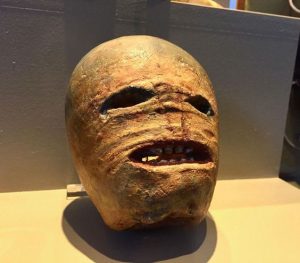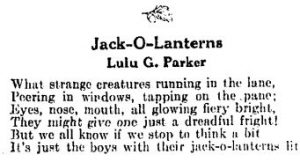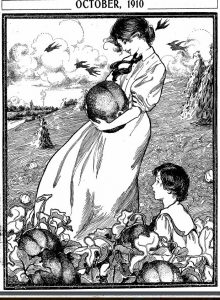Halloween 2016 netted retail industries approximately $8.6 billion (CNN). Millions more may be factored into the season when cafes and grocers market many items labeled as “pumpkin spice.” It’s impossible to mention Halloween without invoking images of costumes, trick-or-treating, pumpkin carving, pumpkin smashing, witches, black cats, etc. Halloween is such a symbolic and long-standing holiday in American culture that it is worth serious consideration by historians, anthropologists, and students of folk-lore. It is the product of the migration of Western Europeans and a fusion of their traditional practices on this continent. Although it is such a historically rich festival, how is it that one of the longest-standing crafts affiliated with All Hallows Eve is that of pumpkin carving? When all is said and done, it seems a tad silly to carve a scary face into a vegetable. Patterns range from happy to scary, from eccentric to mainstream, the patterns reflecting both the skill and the whims of the carver. Why and how did this tradition of pumpkin carving emerge? That annual pilgrimage to a country-side pumpkin patch in order to select the perfect squash canvas? The answer lies with the development of Halloween as an American holiday.
Irish and Scottish immigrants brought many traditions with them as they migrated to North America. A very old Celtic celebration is that of Samhain, which marked the old pagan New Year. On Samhain, spirits of the dead and the realm of faerie mingled with the regular living. People dressed up in order to confuse or aid spirits in what used to be known as ‘souling’ and ‘guising’ and is now known as trick-or-treating. Women chose this day to participate in divination to identify future spouses, the upcoming harvest prospects, and/or communicate with the deceased. This

tradition has continued into the twenty-first century, albeit in different forms, often with the ever-popular Ouija Boards sold for kids ages 8 and up! As for jack-o-lanterns? This too is the result of carried over tradition of turnip carving. Carved turnips sought to confuse and frighten away malicious spirits. The origin story of a jack-o-lantern is equally fascinating: a man who tricked the devil and as a result could neither go to heaven nor hell upon death was cursed to roam the Earth in fiery vegetable form.
Although this lore and imagery principally sustained itself as an ethnic festival within the first Celtic immigrant communities, it began to merge with other autumn festivals in the United States and by the mid to later nineteenth century became cause to celebrate. Celebratory ‘tricks’ in the early twentieth century could be quite destructive, resulting in property destruction, removed gates and fence posts, over-turned outhouses, and going around and spooking individuals just for the heck of it. To counter such ‘tricks,’ popular culture advocated celebrating Halloween in more wholesome ways, friendly to all family. Farmer’s Wife October editions are rife with ideas for party favors, crafts, games, stories, and recipes. Many of the games  center on divination utilizing apple peels and decorating using none other than jack-o-lanterns.
center on divination utilizing apple peels and decorating using none other than jack-o-lanterns.
Why is it that jack-o-lantern carving of turnips transformed toward that of a pumpkin? The pumpkin plays an interesting role in its significance within US History, which is elaborated upon in Cindy Ott’s book Pumpkin: The Curious History of an American Icon. Ott frequently reinforces that the pumpkin, although a relatively valueless crop both monetarily and utility-wise, transformed to represent agrarian ideals and the bucolic imagery of a rustic farm life in a rapidly urbanizing period of American history. As more people fled to cities and began purchasing food in cans the idea of picking a pumpkin and using it to decorate or make the hallowed pumpkin pie, allowed for the newly urbanized individuals to reconnect with nature, if anything, through nostalgia for days of yore when a family could live solely off the land (no matter how realistic such a notion may be). Jack-o-lanterns allow the individual to simultaneously connect with nature and celebrate its unpredictability.

These ideals and symbolism is still entrenched deep within American culture. As you head toward the pumpkin patch, prep for trick-or-treaters, and ready your jack-o-lanterns, pause a moment to appreciate the significant whimsy of the holiday. If feeling particularly inspired, sharpen the knife a bit extra and carve up a turnip! Consult Cindy Ott’s book to learn more, and peruse October 1 editions of the Farmer’s Wife to enjoy Halloween stories and party ideas from the early twentieth century (hint: bobbing for apples)! In the mean time, stay tuned for our countdown to Halloween recipe posts, coming next week!